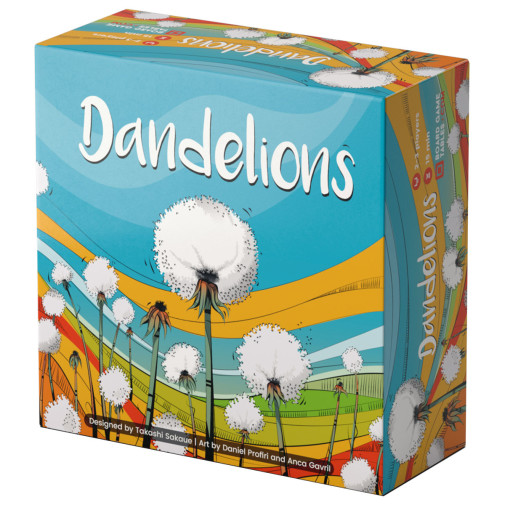We use cookies to make your experience better. To comply with the new e-Privacy directive, we need to ask for your consent to set the cookies. Learn more.
Dandelions Game
- Small parts. Not for children under 3 years.
Gentle seedpods float in the summer air. As they plant themselves in gardens, sprouts emerge. Some gardens are more beneficial for growth, and it is always advantageous to have more seeds land in these. In this 15-minute game for 2-3 players, each person starts with a pawn and 11 dice of different colors that represent dandelion seeds and sprouts. Place the five garden tiles, numbered 1, 2, 3, 5, and 8, in a circle in ascending order. At the beginning of the game, all players roll their 11 dice and keep them in front of their play area. The goal is to plan ahead to choose one die each turn, move your pawn around the gardens, and plant your die in the best possible position to earn the most points at the end of the game!
Turns: Each player chooses one die per turn. Starting on the
first space, each player moves their pawn that many spaces clockwise around the
garden display and plants their die in the garden they land in—unless one of
the following occurs:
Float: If another player’s pawn is already in the space you
land in, move your pawn the same number of spaces once more.
Gust: If a player plants their die in a garden with other players’ dice that match yours, move all matching dice, except for your own, to one of two adjacent gardens.
Puff: If your pawn lands on the start space, pick up all of your
unplanted dice and reroll them.
Once all the dice are planted, the game ends and scoring take
place as follows:
Sprout Score: Each die scores the number of points matching
the garden’s number. For example, if you have three dice in the garden numbered
3, you would gain 9 points for that garden (3 points per die).
Seed Score: The player with the most dice in each garden
adds up the total of their die numbers for that garden and scores that
total.
The winner is the player with the highest total of Sprout and Seed scores. Dandelions is a 15-minute game for 2-3 players with simple instructions that requires keen observation and strategy to win. There is a balance of luck with the die rolls and the opportunities for rerolls as well. I really love playing this game! ~ Marsha
| Product Format: | Other |
|---|---|
| Grades: | 1-AD |
| Brand: | Allplay |
| EAN/UPC: | 618149322893 |
| Length in Inches: | 4.75 |
| Width in Inches: | 4.75 |
| Height in Inches: | 2.125 |
| Weight in Pounds: | 0.55 |
Be the first to review this item

